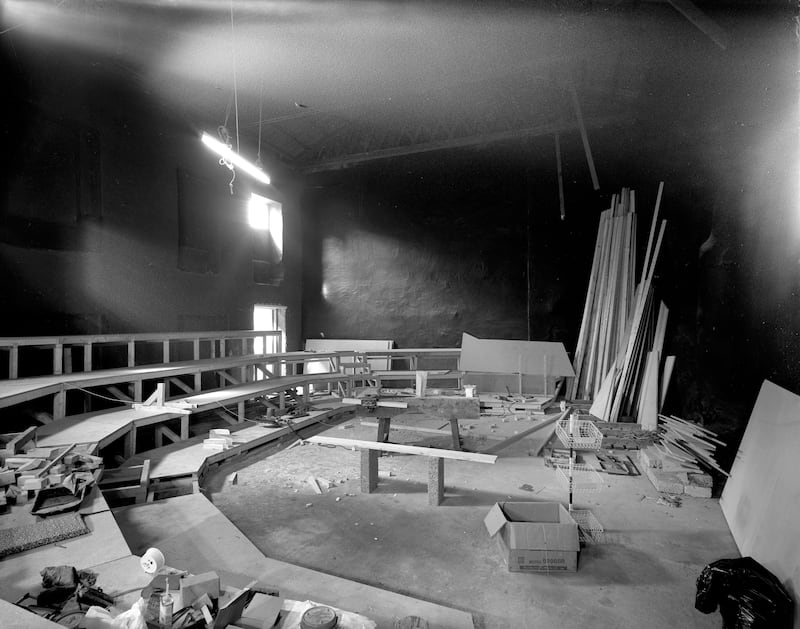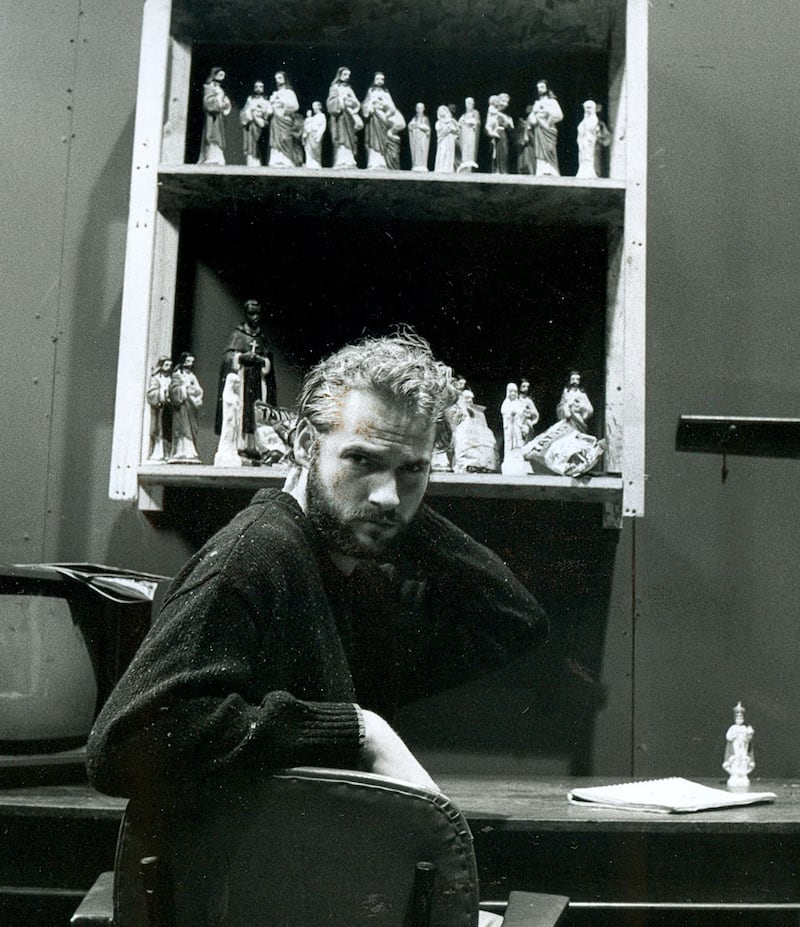Half a century ago this week, in the summer of 1975, Druid theatre company was born in Galway. Founded by the director Garry Hynes and the actors Marie Mullen and Mick Lally, it started with a trio of plays in repertory in the city’s Jesuit school hall. Today Druid describes itself as a touring company anchored in the west of Ireland and looking to the world.
The three plays opening on July 3rd, 4th and 5th that first summer were JM Synge’s The Playboy of the Western World (which Druid has made its own over the years), Kevin Laffan’s It’s a Two-Foot-Six-Inches-Above-the-Ground World and Brian Friel’s The Loves of Cass McGuire. The fledgling company quoted Tennessee Williams in the programme: “Make voyages. Attempt them. There is nothing else.”
Druid’s origin story recounts rehearsing the three plays daily, morning, afternoon and night, with the cast selling tickets on Shop Street. They had to set out chairs and tidy them away again for each performance, carrying in lights and props.
Mick Lally was already a star in the city, acting at An Taibhdhearc, the national Irish-language theatre, while a young teacher at the local VEC. He had to ask for leave of absence from the VEC’s head to join Hynes, Mullen and their group of young University of Galway graduates for the summer. That head was Hynes’ father, handily enough.
RM Block

The company’s name, evoking “a weaver of dreams and spells”, emerged from a crossword clue about the druid in the Asterix comic books.
What self-belief they had.
“I wouldn’t call it self-belief,” Hynes says, laughing. “We were chancing our arm. It took energy and resolution, and a certain kind of complete innocence: ‘We’re going to found a professional theatre company.’”
Notions.
“Not only were we not professional, but I had hardly seen professional theatre. I’d seen quite a bit of amateur theatre. And theatre off-off-Broadway,” during three summers in New York on J-1 visas. “We were met with a sort of scepticism. ‘What do ye think ye are doing, just fresh out of college, trying to establish a professional theatre?’”
That first trio of plays, different in form, tone and setting, together showed “how a century of apparent progress had left many features of Irish life unchanged”, and that “you can never really leave home, that even if you emigrate, you still have to take yourself with you”, as Patrick Lonergan, professor of theatre at the University of Galway, puts it.
The following year Druid produced 10 shows. From the start they built a strong audience in their home city. Lunchtime theatre – 50p for a show and a sandwich – was new: gamble on a short play, to see if you like the experience.
They performed in the Fo’castle, a tiny function room behind the Coachman Hotel on Dominick Street, which they converted to a 47-seat theatre.


Eventually they secured an abandoned tea storehouse on Courthouse Lane from the McDonoghs, at a peppercorn rent; years later the Galway merchant family donated the building to Druid. The gang did the carpentry, plumbing and plastering themselves.
The first production there was The Threepenny Opera, on May 19th, 1979. Decades of theatregoers recall uncomfortable bench seating with red foam cushioning, the black cavern morphing for each production, theatre posters in the tiny lobby, the hatch where you picked up tickets or queued in the hope of cancellations. It has been Druid’s homeplace ever since.

In 1996, for the company’s 21st birthday, Galway City Council renamed the pedestrian street that housed its base Druid Lane. The venue was redesigned by dePaor architects in 2009, reopening with Tom Murphy’s The Gigli Concert. Druid renamed it the Mick Lally Theatre in 2011; the actor had died a year earlier, at the age of 64.
A timeline on Druid’s website, to mark the 50 years, recalls multiple markers as the company built in ambition, skill and reputation, from national acclaim to international tours and multiple awards.
As well as reimagining playwrights from Synge to Shakespeare to O’Casey to Beckett, the company forged long and fruitful relationships with living playwrights. After the 1978 premiere of Geraldine Aron’s Bar and Ger, it produced several plays by the Galway-born writer. From the 1980s it worked with Tom Murphy, a special bond that culminated in its DruidMurphy season, in 2012.
Plucked from a script slush pile, Martin McDonagh’s The Beauty Queen of Leenane was the inaugural show at Galway’s renovated Town Hall Theatre, in 1996, then went to the West End of London. McDonagh’s Leenane trilogy, a year later, was Druid’s first “event theatre”, a marathon of plays in a day, and Beauty Queen on Broadway was nominated for six Tony Awards, winning four: for Mullen and for the late Anna Manahan and Tom Murphy; and for Hynes.

Those relationships with writers culminated in startling theatrical, intellectual, performance-centred interrogations of their work: as well as DruidMurphy, there was DruidSynge in 2005, DruidShakespeare in 2015 and DruidO’Casey in 2023.
Many of us who grew up in Galway remember Druid’s early shows from our teenage years. The actors became familiar faces, transforming from show to show. Mullen, of course, always. Often Lally. Ray McBride, Maelíosa Stafford (who became Druid’s artistic director for five years, in the early 1990s), Seán McGinley, Jane Brennan, Máirtín Jaimsie, Pat Leavy.
You’d go to whatever they did next, because you knew it would be good, a stretch. Dial M for Murder, Ionesco’s The Chairs, A Doll’s House, Bernard Farrell’s I Do Not Like Thee, Dr Fell. It was like an education in theatre, contemporary and classic, all genres, Irish and international.
Going into the tiny Druid auditorium for an early Playboy of the Western World, in 1982, was like stepping into Pegeen Mike’s pub, the thatch above, the scent of burning turf – literally – still in the air. That wasn’t long after Mullen, in her 20s, did a ripe Mrs Bracknell in The Importance of Being Earnest.
In 1985 we were in the midst of the pub intimacies in Murphy’s Conversations on a Homecoming, which later spread wings to Dublin and abroad, and were feet from a wild-haired Siobhán McKenna in her final stage role, in Bailegangaire, which Murphy wrote for her.

From 1986 Druid performed internationally. In Galway it ventured beyond Druid Lane too. We recall Páraic Breathnach, who was building the set for an epic production of Murphy’s play Famine in 1984 (and would soon co-found Macnas theatre company), showing us around the western landscape they were creating on the floor of the Seapoint Ballroom in Salthill: hillocks, rocks, undulating ground, made from small, numbered pieces of plywood.
That local audience seamlessly became national. But for those of us young and impressionable in the early years, we thought it was normal to have superlative, expansive, intimate, skilled theatre on the doorstep, opening the mind and heart.
Druid has always worked as an ensemble, informally or formally, with actors and a consistent team of creatives and crew. It seems part of the chemistry onstage, and to forge a cohesiveness, a progression in the work they present. “You could write a history of Druid through the history of about five ensembles,” Hynes says.
This approach, the groups morphing and overlapping as time passes, allows a “continuing conversation” in rehearsals. “You don’t go into a room starting from scratch all the time. You go into a room with these understandings of each other, liking for each other, love for each other, experience.
[ Picture story: Druid Theatre prepares to mark 50 years with Shakespeare and SyngeOpens in new window ]
“In theatre it’s actually truly a privilege, and a huge benefit. Such a different way of working than normally people have to work in this business, where everything is ab initio, starting from the top all over again.”
Over the past weeks, in rehearsals for Druid’s double bill of Riders to the Sea and Macbeth, which it is staging as part of Galway International Arts Festival, Hynes has been struck by “the absolute privilege it is to actually celebrate 50 years of life in the theatre, working consistently with a group of people – none more than Marie.
“To have been in rehearsal with Marie in 1975, and to be in a rehearsal room with her today, to have worked together consistently over that period. Then that being echoed by the long relationship with actors, whether Maelíosa Stafford or Seán McGinley, to the ensemble now.”
The pairing of Synge’s drama with Macbeth (which features Marty Rea as Macbeth and Mullen as Lady Macbeth) picks out two strands of the company’s work: west of Ireland plays, and its exploration of Shakespeare. (Another strand features when Samuel Beckett’s Endgame opens in New York in October.)
Five decades on, Druid is still very much made in Galway. Druid has its own shops, building its sets and making its costumes here.

At an industrial estate in the northeast of the city, Barry O’Brien, a production manager who has worked with the company since the 1990s, has been supervising construction of the dark, dramatic set for the double bill, designed by the long-time Druid collaborator Francis O’Connor.
Gus Dewar, a carpenter who has worked with the company for 25 years, leads construction, following O’Connor’s model box. In the small maquette on a table the miniature planks are slightly offset, there are tiny LED lights, and different levels of seating banks are visible. The (very limited) audience will inhabit the dark world of both plays along with the cast, within its walls.

Sections of the full-size set are in the middle of the space, half-made, being painted by scenic artists. Behind that, industrial shelves reach to the ceiling, holding furniture from multiple Druid shows.
Set have been made and stored here since 2016, making it possible to keep and reuse much. There must be hundreds of chairs of various styles, plus tables. Many are frequently reused; black chairs from The House, and The Seagull at Coole Park. Some are shrink-wrapped to keep them together.
There are stacks of floors and set bases, including two DruidO’Casey floors: “We had to build two sets because it was going to America.” Then again, “The House last year was 90 per cent recycled from DruidO’Casey, flats and floors repurposed.”
On top of a dismantled scaffolding tower sits the gorgeous purple chaise longue from Sonya Kelly’s Furniture, which Druid staged in 2018; it was upholstered in Westport. It has since been used in photoshoots, including for the programme of last year’s Galway International Arts Festival.

Beside the chaise longue is a bare tree trunk from Druid’s 2016 production of Waiting for Godot. The juxtaposition catches you. On a large shelf stuffed with rocking chairs, one is the Beauty Queen original, according to O’Brien. Hessian sacks filled with a fire-retardant beanbag mix were in Eugene McCabe’s King of the Castle in 2017.
We go upstairs, past sound and lighting equipment and shelves of lighting gels, with a huge poster on the front, from Playboy and Shadow of the Glen, which Druid brought to the Kennedy Center, in Washington, DC, in 2008. They took it down from outside the theatre afterwards, O’Brien says.
Upstairs is impressively organised. There’s a bag of swords from DruidShakespeare (heading now for Macbeth), plus two spinning wheels, one of which will feature in Riders to the Sea.

There are shelves of labelled boxes: Money; Hairbrush, Hairdryer, Makeup, Hand Mirror, Fans; Toys & Hobbies; Handcuffs & Shackles; Flashlights etc; Medical Paraphernalia; Picture Frames; Mobile Phones; Medals; Blood Bags (for effects: “we make them ourselves with cling film”); Cigarettes & Tobacco; Matches & Lighters; Religious Pictures (“people are always giving us religious pictures”); Flowers.

Across the way are shelves of sorted crockery and kitchen stuff. An old-fashioned shop weighing scale (“from Big Maggie, I’d say”). An old American coffee machine, loads of oil lamps, miniature radiators (“I wouldn’t chance plugging them in now”).
In Nun’s Island in the city, Druid’s head of costume, Clíodhna Hallissey, is experimenting with colleagues on a jacket for Macbeth, cutting out a pattern for a toile, or mock-up, of a slim-fitting padded jacket, to see how it suits Marty Rea.
She and Francis O’Connor are designing costumes for the double bill. Hallissey, who is from Connemara, studied drama at the University of Galway. After winning Druid’s Marie Mullen bursary, in 2019, she started working on costumes for its production of The Cherry Orchard.

They also store outfits here from the past 15 years or so. Costume space used to be transient, so “we don’t have costumes from Beauty Queen or any of that, which is really heartbreaking”.
The costumes tell Druid’s story from another angle. In this Aladdin’s cave there’s an opulence but also a reality, as we step over some basins left out to collect drips on a rainy Galway day.
Inside, beyond the workroom, it’s like a charity shop, but with an exotic selection, and incredibly detailed categorisation. There are racks and racks of clothes, with labelled sections: Short-sleeved Cardigans, Button-up Cardigans, Chunky Button-up Cardigans, Chunky Pullovers, and on and on.

We count 13 rails in this room. Maybe 60 items per rail. That’s just the women’s. Down further is a room of men’s costumes, and one with shoes and boots. Hallissey has no idea how many items are here. “It’s in a constant state of reorganisation.”
She’s planning a small costume display for during the run, in the Hall of the Red Earl, opposite the Mick Lally Theatre. A costume Aaron Monaghan wore as Richard III looks like chain mail, a sort of quilted leather jacket and shoulder piece with layered sleeves, overlaid with bronze and silver sequins and studs. Richard walked with a limp and had a hump; one of Monaghan’s feet was bound each night, alternating between them to even the strain.
A long black lace and wool dress with a high Elizabethan neck and lace collar, which Siobhán Cullen wore as Lady Anne in Richard III, has punky spikes on the shoulder, and a harness attached to the dress’s long train. “She drags the body on stage with this.”
Hallissey takes out sickly Mollser’s green dress and apron from The Plough and the Stars. “We used Irish linen as much as we could for O’Casey”, from Emblem Weavers in Wexford, a natural fabric to complement the set.
Rosie Redmond’s tatty pink satin bloomers have seen better days. “These are my favourites. She’s been in the Monto a long time.” They had them made. “You should have seen these, so pristine and beautiful. ‘Thank you so much: we’re going to wreck these.’ We had to go at them with paint and a grater to give this lived-in feel. It was painful to have to destroy them.”
We look at costumes from Thomas Kilroy’s version of The Seagull at Coole Park, during Covid. “They are not very washable for an outdoor show. We were praying there would be no rain, because trying to dry these before the next day ... We had to give a sense of the time period, so we couldn’t make everything waterproof.”
In Druid’s professional shops, Hynes says, “I think we’re making a particular contribution to the Irish theatre industry, by preserving the skills of propmakers, carpenters, electricians, costume designers, costumemakers. We’re keeping those at home.
“There’s crews that started to grow up, just as much as the actors in ensembles, around Druid. Not only did we as actors start to learn skills, but so did the crews. I personally feel our crews are the best in Ireland, possibly the best anywhere.”
Hynes explains the choice of Macbeth and Riders to the Sea for Druid’s anniversary. “We had to do a Synge”, and they’d always talked about Macbeth but “always felt very afraid of it”.
She instinctively felt connections. “They’re plays where time is not a sequential, consecutive thing: it moves back and forth, like I think it does in people’s minds. They connect children. They connect the spiritual, the superstition. Then there’s our relationship with Synge and our relationship with Shakespeare.”
Half a century is a milestone. International reach and kudos, but still a local theatre. World stage, still made in Galway.
Druid’s double bill of Riders to the Sea and Macbeth opens at the Mick Lally Theatre on Tuesday, July 15th (with previews from Thursday, July 10th), and runs until Saturday, July 26th, as part of Galway International Arts Festival; all performances are sold out. Macbeth moves to the Gaiety, as part of Dublin Theatre Festival, from September 25th until October 5th






















